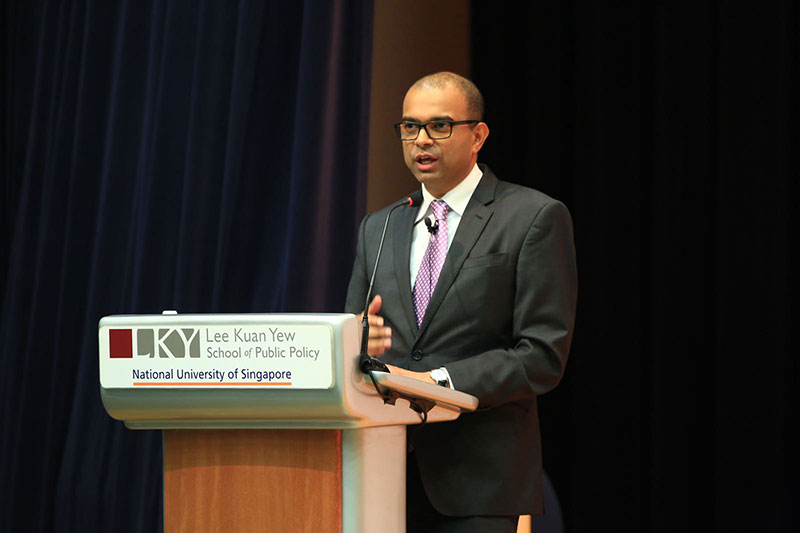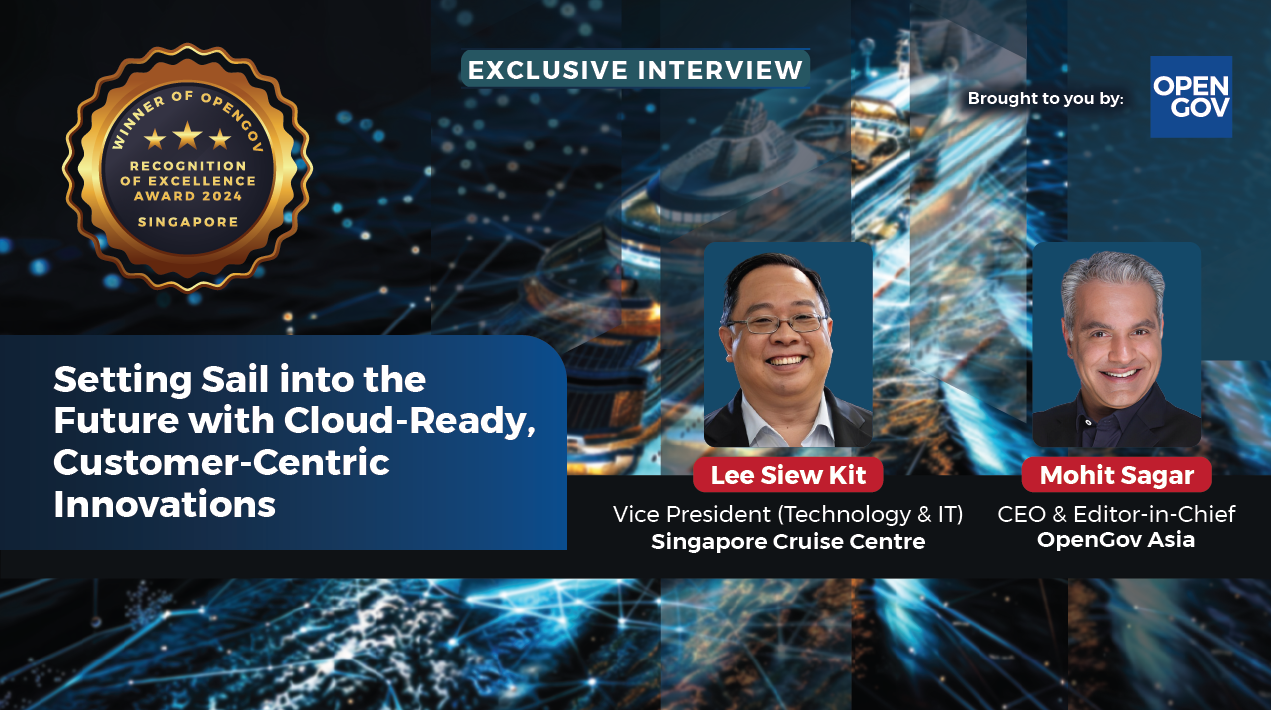
“The hyperbole, the speculation, the breathless commentary
on artificial intelligence (AI) can potentially generate quite a lot of
confusion, quite a lot of anxiety, but that process doesn’t necessarily lead us
any closer to a solution.”
Dr Janil Puthucheary, Senior Minister of State, Ministry of
Education and Ministry of Communications and Information and Minister-in-charge
of the Government Technology Agency (GovTech) started his public lecture on the
‘Societal implications of AI’ at the Lee Kuan Yew School of Public Policy (LKYSPP) on 6 April, with these words. The
session was moderated by Associate
Professor and Co-Director, Institute of Water Policy, Eduardo Araral.
In his address, the Senior Minister of State attempted to
cut through the hyperbole. He talked about the role of Government policy and
regulation and outlined Singapore’s approach in the area of AI.
He said that we need a healthy exchange of considered views
between regulators, academics, practitioners, and technical professionals
together to work out a practical approach to the socio-economic issues and
concerns posed by AI.
A pragmatic policy
response
Dr Puthcheary pointed out that the hyperbole suggests that
AI is already transformative to the point of causing huge disruption. But the
reality is that many of the technologies that are mature enough today for
deployment, such as image recognition and speech processing, are narrow and
function-specific. They are focused on existing business opportunities, and
process. They augment and assist human decisions.
Also, as the technological revolution progresses, what was
previously seen as ground-breaking technology and was viewed as the remit of AI
researchers, becomes commonplace accepted computational capabilities.
“It means that from a policy perspective, we need to focus
on the risks and issues that can be foreseen on the basis of what is happening
today and perhaps accept that there will be unknown unknowns and we will deal
with them when the time comes,” Dr Puthucheary said.
This requires a pragmatic policy response, to ensure that
the technology is allowed to develop and mature without hindrances, while
protecting public interests.
The speed and the scale and the pocket-sized nature of the
computing ability might be new. But the approach is not. Singapore has adopted
this approach previously around technological revolution and has always
recognised that risks are inherent in all systems, as they are even in human
control systems. The question then is how can the potential risks be mitigated,
while maximising the benefits. The idea is to develop a risk-based approach,
building accountability and trust.
Key features of the
Singapore approach
Being proactive and providing early regulatory clarity
Dr Puthucheary said, “On a national basis, we need to, we
want to, and we will be pro-active. We need to be an active player and
influence and shape the development of this space.”
This complements Singapore’s hundreds of millions of dollars
of investment in developing AI capability, through initiatives such as the Smart
Systems Strategic Research Programme and AI Singapore, along with support for the
industry to adopt AI and using AI for improving public service mechanisms.
Concurrently with the above-mentioned initiatives, Singapore
has to develop governance frameworks to support trustworthy and acceptable use
of AI. Doing so early and thereby providing regulatory clarity will encourage
businesses to invest in Singapore and create jobs and also help in the
development of international norms.
Moving towards an industry-based approach
Dr Puthucheary said that Singapore has started putting in
place structures and programmes to address AI risks and governance approaches.
There is a regulators’ roundtable, with regulators across
domains such as transport, health and finance. This horizontal approach of
looking across domains is useful for areas where AI development is at a nascent
stage and the impact of AI where regulatory response might be required is not yet
clear.
“Where things are still developing, we are looking
horizontally across domains, trying to bring the skills together, making sure
we produce the platforms, such that when the knowledge is there, when the
opportunity is there, they will be rapidly propagated across our system,” Dr
Puthucheary explained.
But in sectors where disruption is already happening, Singapore
is taking an industry-specific approach. One example is finance. The Monetary
Authority of Singapore (MAS) is bringing
together thought leaders, practitioners of data analytics and various
professionals in the financial sector to develop a guide for promoting the
responsible and ethical use of AI and data analytics by financial institutions.
While setting up broad horizontal structures, Singapore aims
to move towards an industry-specific approach as far as possible. Dr
Puthucheary emphasized, “When it becomes clear that there is the need, the capability
and the regulatory opportunity to do so, go for an industry-specific approach.”
Adoption of cross-industry principles for Explainable, Fair and Safe AI
Though there is no one-size-fits-all solution or a generic
AI risk governance framework, still some broad principles are required for the
purposes of public accountability and business confidence.
1. The first is to try
as hard as possible to ensure that the algorithmic decisions, the output of
AI-driven processes are explainable and transparent, to a reasonable degree.
“But from the point of view of the relationship between the
industry and the regulators we need to develop the maturity around that process
to expect that we have to explain ourselves to the public about these AI-driven
algorithmic decisions in way, that the public accepts is sufficiently
transparent and fair,” the Senior Minister said.
2. The second principle
is about fairness, in the sense of the removal of human bias.
Depending
on how we engineer AI-driven solutions, there is a possibility that existing
human biases will be get hardcoded into the system, that they will be amplified
and institutionalised.
So, it needs to be objectively demonstrable that the
deployment of AI-based or algorithm-based solution is not amplifying,
institutionalising or coding in human bias. This includes bias that may have been present
before or new bias that has been allowed to creep in.
In areas such as healthcare, defence and security, this is
of critical importance.
3. The third and final
principle is safety.
As increasingly consequential decisions are entrusted
to these support technologies, the public has to be repeatedly reassured of
their safety and well-being.
The tolerance of harms and risks needs to vary with
industry. But as Singapore goes down this development path, there has to be
high regard for the role of safety. Both industry and regulatory organisations
have to assume responsibility for risk and impact assessments, adequate
testing, and necessary limits to mitigate harm.
Dr Puthucheary cited the Land Transport Authority (LTA)’s approach
to autonomous vehicles as an example. LTA has imposed a progressive testing
process, which progressively moves up to more challenging conditions and wider
spaces, and holds the autonomous vehicles to a safety bar that is much higher
than a human would be.
This seems to go against the grain of the argument that
ultimately autonomous vehicles would be safer than human drivers. But along the
journey to get to that the ultimate onjective, Dr Puthucheary explained, that
argument has to be reversed and the regulator must ensure that that higher
safety standard is delivered and objectively demonstrated.
Conclusion
The Government needs to be agile in responding to a rapidly
evolving technology such as AI. All of the above might need to change in six
months from now.
The Government must also continue to invest in people and
ensure that Singapore has the right educational base; develop infrastructure to
support the connectivity that is a key requirement for the development of these
types of technologies and their deployment; and develop public sector
capabilities to ensure that these tools are used maximally for the public good.
The Government wants to partner with industry for every step
of the way, from thinking about the development, research, regulations and to
finally providing these solutions.
“We are only at the start of what could potentially be a
very exciting and transformative journey around deployment and development of
AI,” Dr Puthucheary concluded.
“We should move away from the hyperbole, think about it with
some degree of pragamatism, but also a bold vision. We have to believe that
this a space which we can get into and do things with, manage the risks, reduce
the harm, and ultimately exploit the benefits to help our society.”
[1] Earlier
algorithmic decision-making systems relied on rules-based, “if/then” reasoning.
But machine learning and its subset, deep learning systems create more complex
models in which it is difficult to understand why and how decisions were made.
That’s why deep learning systems are often referred to as black boxes.
















